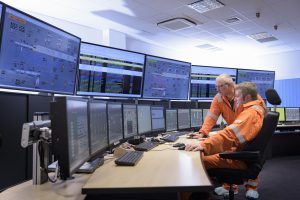Nothing is more satisfying to CFOs than seeing how energy adds value to the bottom line. Most CFOs see energy as a cost, not an investment. Today, a group of energy efficiency champions emerging from within organizations are changing the mindsets of executives. This heroic group is willing to take matters into their own hands to cut energy costs. Let’s call them building managers (other titles include plant operators and facility managers). Their challenge is to convince executive decision-makers that investing in energy management solutions is a smart business move.
What’s driving the move to energy efficiency across business? There are several influencers. Among the most visible are governments. In Europe, improving energy efficiency and costs is a top agenda item. Building owners can turn to the Energy Performance of Buildings Directive to learn how energy automation and control technology minimizes energy waste.
Europe tends to beat North America hands down when it comes to environmental responsibility and sustainability. But programs like the Better Buildings Challenge bring together U.S. organizations to enhance collaboration and solve energy issues.
Government-sponsored energy programs are good for all of us. But, some continue to wonder about the business benefits. This is why operational cost savings and increasing energy prices are the top influencers which compel organizations to implement energy management software.
While building managers are privy to the types of solutions that reduce energy costs, executives may not be so informed. So it’s up to building managers to promote how investment in energy management solutions delivers financial benefits.
First, focus on the business benefits, like how integrating power automation and control with energy monitoring can improve energy efficiency and deliver cost savings of up to 30% a year. Then, explain how technology helps to find out details about energy consumption and energy waste, and identifies areas for energy cost savings.
Next, describe the technical advantages, like how integration and analysis of energy data and production data is simplified with a comprehensive energy management infrastructure. Dig deeper and discuss the benefits of linking power meters to process control human machine interfaces. Indicate how the right tools can perform comprehensive analysis of power metrics alongside process information. And, show how the total view of inputs and outputs, including materials, consumables, energy, waste, and carbon emissions, makes it easier to identify potential savings.
Executives are concerned about business continuity, so be prepared to talk about how building and maintaining a balanced power distribution system with a library of applications supports overload detection and load shedding at the control system level. Emphasize how this maximizes energy distribution efficiency, which lowers energy costs.
User-friendliness of a system is also a deciding factor. Present how easy it is to centralize energy use data into meaningful dashboards and match kWh costs to production processes with the right tool.
CFOs may need convincing that energy automation and process control is good for the bottom line, but it shouldn’t be hard if the facts are presented correctly.




Conversation
Hi Nick,
I think that more that a job for the CFO. This is an activity that falls more on the realm of the COO. Because in general we are chartered with some of the following activities: Implement Strategy, Reduce Costs, Improve Efficiency, Supervise New Product Development and Oversee Compliance to all sorts of Regulations.
The CFO’s in most cases are more adapt to perform financial and accounting activities, than to look for technologies that will make the organization more competitive and set the basis for sustainable growth.
For sure Clean Energy can reduce costs, comply with EPA and other regulators, etc.
Rogelio.
Hi Rogelio – Thanks for the comment. I agree that all c-suite stakeholders would (and should) be concerned about implementing efficiencies and reducing costs. So to your point, COO individuals should absolutely be involved. The more senior leaders that are on board with implementing organizational wide efficiencies the better, plus it brings more areas of the business together to ensure a comprehensive strategy is deployed.
Nick